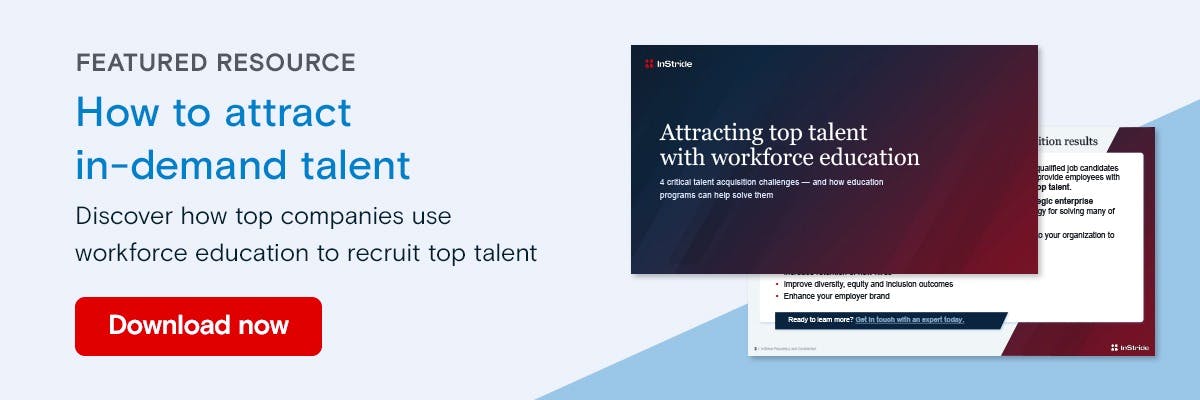Employees are an organization’s greatest asset. Without a community of dedicated workers, your business can’t thrive — regardless of how fantastic your solution is. Plus, maintaining a diverse and high-quality workforce can be a major competitive advantage.
Research-backed data demonstrates that business leaders recognize how talent drives business performance. Globally, 48 percent of corporate leadership says their management team fully recognizes the connection between human capital and business performance. With this in mind, another 48 percent say they plan to expand employee engagement programs in an effort to further accelerate their companies.
We know that talent drives performance. But the question still remains, how do you cultivate top talent within your organization? Is it a matter of hiring external workers or developing talent within your company
Even the largest companies with countless resources and robust people processes still struggle to answer this question and put it into practice. In this article, we break it down piece-by-piece.
The difference between talent acquisition and talent development
Although you’re likely already familiar with these terms, it’s still important to distinguish the difference. Let’s begin with a brief refresher.
Talent acquisition and talent development are both vital people operations that must coexist within an organization. Each strategy functions to support a culture of engaged and highly skilled workers within an organization. But in practice, these two strategies look very different.
Talent acquisition works through a process of scouting, recruiting, selecting and onboarding new employees. The idea with talent acquisition is to find new job candidates who have the skills and experiences needed to fill a new role within a company.
Talent development refers to the processes put in place to train, engage, motivate and retain current employees. This also means equipping employees with the tools they need to build upon specific skills needed to succeed in their current role, as well as future positions.
The advantages of hiring externally
When evaluating your current people strategy, it’s important to understand the advantages of looking outside your organization for top talent.
At a high level, talent acquisition is an effective approach for:
- Filling specialized positions
It’s not uncommon for organizations to have mission-critical positions that require a very specific set of skills. There might be internal employees that are on the right path towards being a fit for the role, but they just aren’t there yet in terms of experience or skills. In this case, recruiting external candidates is the most efficient way to fill an opening. - Introducing outside perspectives
Diversity in the workplace is top-of-mind for nearly all business leaders right now. Acquiring talent externally allows your organization to bring on new team members with varying backgrounds, levels of experience and a fresh perspective from outside of the company.
Cost of acquiring external talent
The true cost of talent acquisition depends on a number of factors, including the size of your business, industry, the time it takes to fill a position and which technologies you use to source job candidates. A 2022 study from SHRM estimates an average cost of $4,700.
The advantages of hiring internally
Let’s briefly review the key advantages of developing and hiring existing employees:
- Address skills gaps
The rise of digital transformation has brought on an unprecedented global skills shortage. In a recent InStride study, 68% of decision-makers surveyed reported that skills gaps in their current workforce are limiting the organization’s growth. Prioritizing internal talent development allows business leaders to effectively address these gaps through various L&D channels, such as workforce education programs. - Boost engagement
Disengaged employees are often unproductive and lack motivation. People want to feel confident in their skills and know that their hard work will pay off. The right development initiatives can do exactly that — arm your employees with the tools they need to grow their skills and get to the next level of their careers. In a recent LinkedIn study, 94% of employees stated that they would stay in their current role longer if the company invested in their professional development. - Retain top talent
Top-performing employees are often eager to learn and advance their careers. Lack of growth and development opportunities are frequently cited as a major contributing factor to employee turnover. Randstad survey data shared that 47% of higher educated workers said a limited career path could get them to leave for a better opportunity.
Cost of hiring internal talent
Similar to acquisition, the cost of developing talent is largely dependent on factors that are unique to your organization. Employee learning and development programs come in many forms — some more costly than others. A 2020 report by Training magazine found that for large companies the average cost of training and developing an employee was $581 per employee.
Finding a balance between hiring externally and internally
As with many business challenges, there’s no quick-and-easy solution. The short answer is that your organization should be focused on both, with an emphasis on developing employees. Here’s why.
People teams can’t function without either acquisition or development. When evaluating your approach to talent management, you don’t have to choose one or the other. Both of these strategies are integral to cultivating a highly-skilled and productive workforce.
However, many companies rely heavily on external recruitment and often overlook the advantages of developing internal talent. Recruiting quality employees in a competitive market can be an expensive process and does not mitigate the need for learning and development initiatives.
In many cases, it’s far more cost-effective to promote talent from within and facilitate a culture of learning which contributes to the long-term trajectory of your business. Doing so also improves retention and allows you to plan for the future by enabling employees to grow the in-demand skills needed to fill future internal positions.
Plus, having a robust talent development plan can actually fuel your recruitment efforts — 1 in 5 job-seekers are looking for professional development opportunities in a new position.
For these reasons, consider prioritizing talent development and the upward mobility of your current employees alongside your talent acquisition efforts. Doing so can save your company resources and will help to build a community of dedicated and engaged employees.
Ready to upgrade your employee development strategy? Download this 5-step guide on how to rapidly reskill your workforce.


